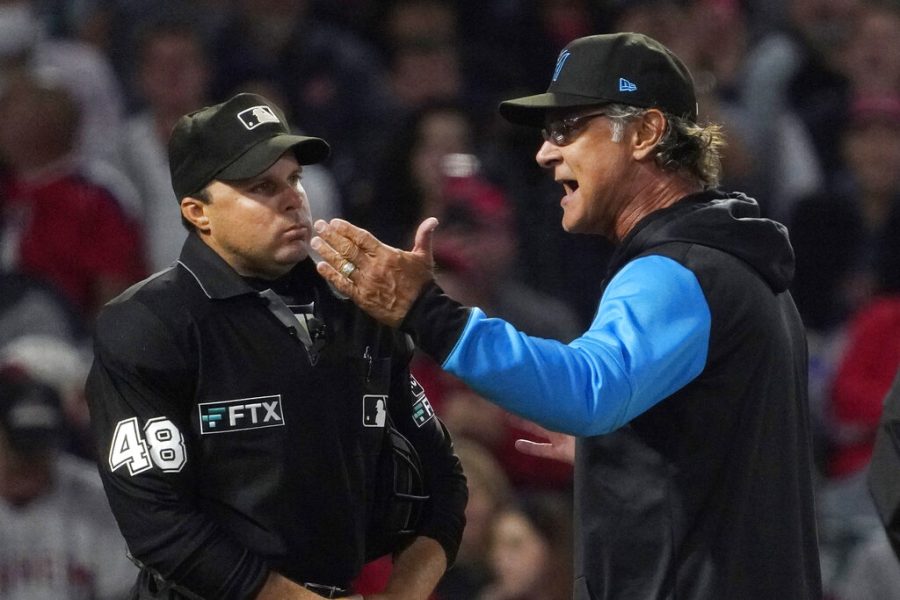MLB implementing automated strike zones in minor leagues causes mixed reactions
AP
Miami Marlins manager Don Mattingly, right, argues with home plate umpire Nick Mahrley after being ejected during the fourth inning of a baseball game against the Los Angeles Angels Monday, April 11, 2022, in Anaheim, Calif. (AP Photo/Mark J. Terrill)
April 14, 2022
There has been a symbiotic relationship between players and umpires since the beginning of the sport of baseball. Athletes would not be able to play games fairly without the officials overseeing the rules, but disputes between the two parties involved over balls and strikes can arise regularly. With the implementation of advancing technology, the process by which pitches are called in baseball is changing, and opinions are mixed on where lines should be drawn.
Robot umpires have recently started to be used
In the 2021 season, Major League Baseball approved the usage of an Automated Ball-Strike system in the Low-A Southeast League. This is not the first instance of robotic umpire experimentation. The independent Atlantic League of Professional Baseball started using automated strike zones in 2019 but recently announced they would go back to only using human umpires for the 2022 season.
“I like the experimentation,” said Andre Demetral, a sophomore infielder on the NIU baseball team. “It has been a question for so long, and seeing it finally happen is pretty cool, regardless if it is effective or not.”
There is not a clear consensus on the issue yet or a commitment from the MLB to fully ditch human umpires as of right now. However, both sides of the argument have continued to express their take on the subject and the implications technology could have on sports in general.
Automated strike zones would be more accurate
The main argument to make the switch to robot umpires lands on the fact that human error could be eliminated completely when it comes to calling balls and strikes.
“Umpires, especially in college, are pretty inconsistent, and pitchers tend to get the benefit of the doubt,” Demetral said. “It would be nice to be able to take a borderline pitch and know it’s going to be a ball.”
The process of implementing the Automated Ball-Strike technology does not completely forgo human umpire counterparts. In baseball games that are using the technology, an earpiece is used to signal to a normal umpire whether each pitch should be called as a ball or a strike. Then the umpire will make the call as normal, but based on the information they are told to say.
Fred DeJesus was one of the first umpires to experiment with the technology with the Atlantic League in 2019, according to a Nov. 1, 2021 CBS News article. After being apprehensive at first, he eventually became more comfortable with the system and recognized its benefits.
There are often discrepancies between what the sizes of strike zones are set as. Each umpire can have a different opinion. The height of batters changes the location of the top and bottom of the zone, along with other conflicting factors.
The Automated Ball-Strike system sets a definitive strike zone that will not fluctuate during an at-bat.
While the technology has come a long way and has proven itself to be accurate enough to be approved by the MLB for minor league usage, the question at hand has changed from “can we do it?” to “should we do it?”
Baseball purists don’t want the sport to change too much
As “America’s pastime,” baseball has a long reputation for preserving the history of the game and its traditional values and rules. To some, umpires are a part of the core of baseball and it would be hard to imagine the sport without them.
“I think the tradition would be too important for this transition to ever happen,” Demetral said. “The human aspect in referees and umpires is irreplaceable.”
The other part of the argument against automated strike zones focuses on how much the change would affect strategy for pitchers and catchers.
Pitchers might start making negative drastic changes to their approach if they are no longer able to trick the umpire with a pitch on the edge of the zone to try to widen the strike zone because a computer would recognize it as a ball, according to an Oct. 20, 2021 Washington Post article by Adam Kilgore. The side effects could involve pitchers moving to more increased velocities, leading to injuries and pitching changes occurring more often.
“There are a lot of little things that people don’t think about that could change,” Demetral said. “One of the most sought after skills in a catcher is the ability to catch borderline balls in a way that makes them look like strikes. Robo umps would make this skill irrelevant and make the catcher position much more offense oriented.”
Regardless of how the technology is implemented or what the public reactions are, change seems to be inevitable. The way that players interact with umpires is certain to change as automated strike zones become more commonplace. It remains to be seen how sacred the process of arguing over a pitch being a ball or a strike is to the sport of baseball or if doing away with the uncertainty would benefit both parties in the athlete-referee relationship.







